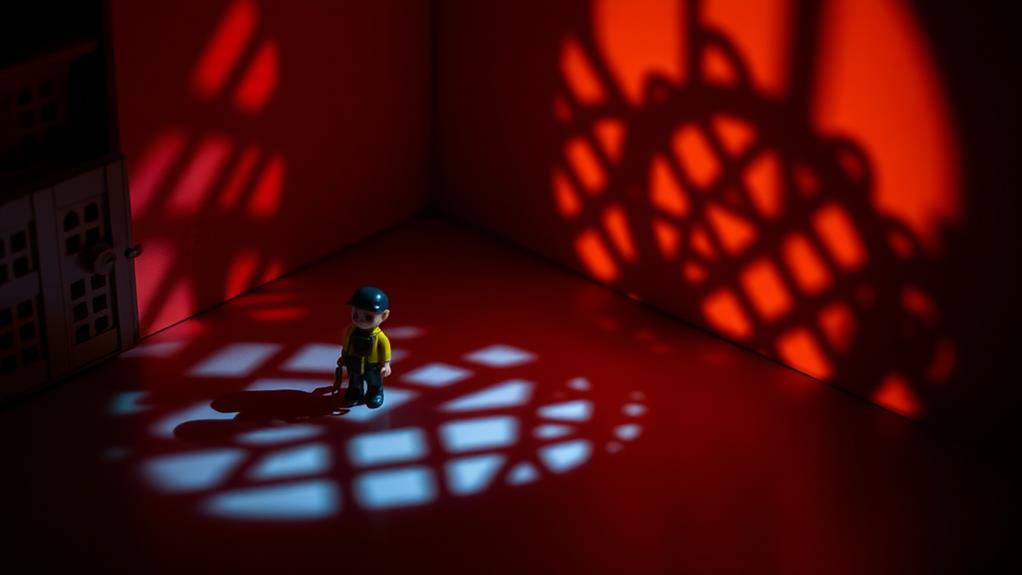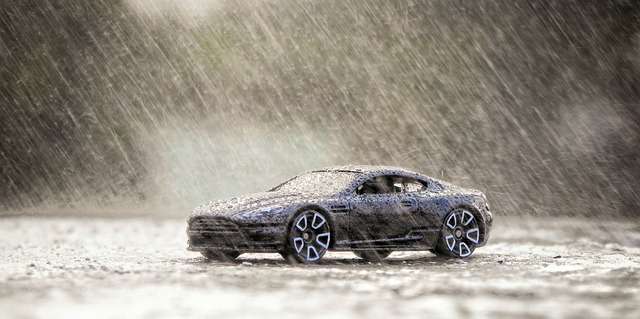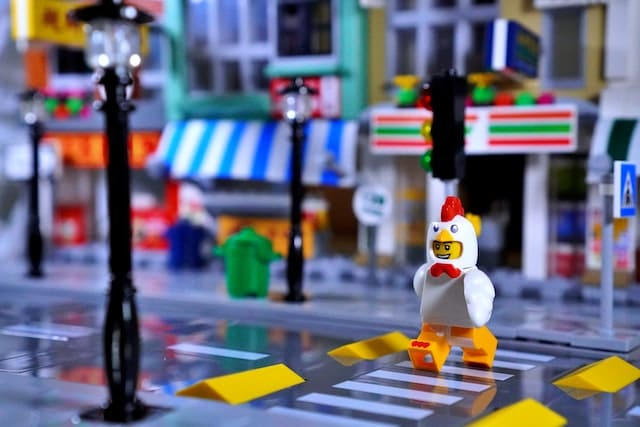Exploring unconventional angles in toy photography adds depth and stories to your shots. You can capture toys from low angles to emphasize their grand stature or use high angles for a playful look. Try tilting your camera for dynamic action shots or concentrating on textures by taking close-ups. These angles highlight unseen details and create engaging narratives. Experiment with light and shadow to evoke mood, and pay attention to environmental contexts to enrich your storytelling. Through these techniques, your photos become vibrant and enthralling. With a few adjustments, your toy images can transform into captivating scenes worth exploring further.
Emphasizing Scale and Proportion
Capturing the perfect toy photograph often hinges on how well you emphasize scale and proportion. You'll want your toys to appear larger-than-life or seamlessly integrated into their surroundings. Start by considering the angle from which you shoot. A low angle can make a toy figure look imposing and grand, while a high angle might give a more diminutive, playful perspective. Think about what you're trying to convey and choose your angles accordingly.
Next, pay attention to the background. Use elements in your environment to help emphasize the toy's scale. For instance, placing a small action figure next to a large household item can create an interesting contrast, making the toy appear even smaller or the item larger. Adjust your focus to blur the background, creating a sense of depth and making the toy stand out.
Lighting also plays a significant role. Shadows can add depth and dimension, enhancing the toy's presence. Experiment with different light sources and directions to find what best highlights the toy's features. Remember, the goal is to create an image that captivates and tells a story through the clever use of scale and proportion.
Creating Dynamic Action Shots
To create dynamic action shots in toy photography, focus on conveying movement and energy. You want your audience to feel the excitement as if the toys are about to leap off the screen. Start by considering the angles and perspectives. Low angles can make your toys look larger than life, while tilted or diagonal angles add a sense of momentum. Think about how the background and foreground interact to enhance the action.
Here are three tips to enhance your dynamic shots:
- Capture Motion Blur: Use a slower shutter speed to introduce motion blur in the background, suggesting speed and movement. This technique is great for depicting running or flying toys.
- Freeze Action: Alternatively, use a fast shutter speed to freeze the action, capturing sharp, clear images of your toys in mid-leap, jump, or kick. This creates a snapshot effect, bursting with energy.
- Use Props and Effects: Incorporate props like smoke, dust, or water splashes to simulate dynamic environments. These elements bring drama and intensity to your shots, making the scene feel alive.
Highlighting Textures and Details

In toy photography, your camera's lens is the gateway to revealing the intricate textures and details that make each toy unique. By exploring unconventional angles, you can accentuate these elements and provide a fresh perspective. Shooting from a low angle or an extreme close-up can uncover details often missed at eye level. These perspectives highlight textures like fabric patterns, metallic sheens, or tiny molded details, making your photos more compelling.
When you experiment with lighting, you can enhance these textures even further. Soft light can create gentle shadows that emphasize depth, while harsh light can bring out fine details. Consider using natural light or a small lamp to direct light where it's needed most.
Here's how different angles and lighting can affect your photos:
| Angle/Lighting | Effect |
|---|---|
| Low Angle | Emphasizes scale and grandeur |
| Close-up | Highlights minute details |
| Harsh Lighting | Enhances texture by creating sharp shadows |
Enhancing Narrative and Storytelling
When you approach toy photography, think of each shot as a scene in a story waiting to be told. Unconventional angles can breathe life into your narrative, transforming simple toys into dynamic characters. By changing your viewpoint, you engage the audience, drawing them into the world you've created. It's not just about capturing a toy; it's about conveying a message, a feeling, or a moment. You can evoke emotions and spark imagination with just a slight tilt or a dramatic low-angle shot.
Consider these scenarios to enhance storytelling in your toy photography:
- Heroic Perspective: Capture a toy from below to give it a larger-than-life appearance, making it the hero of your story. Imagine a tiny figure towering over a cityscape, evoking a sense of triumph.
- Conflict and Drama: Use a side angle to show two toys in confrontation, highlighting tension. Picture the dramatic standoff between a superhero and a villain, with shadows adding intensity.
- Journey and Exploration: Shoot from behind a toy as if it's starting on an adventure. Visualize a figurine walking through a dense forest, leading viewers to wonder what lies ahead.
These angles invite viewers to explore the narrative you've crafted.
Experimenting With Shadows and Light

Just as angles can tell a story, shadows and light bring depth and mood to your toy photography. When you experiment with shadows, you create a sense of mystery or drama that draws viewers in. Try placing your toy figures near a window or under a lamp to cast intriguing shadows. Observe how different light sources can transform a scene. Natural light provides a soft, even glow while artificial light lets you control the intensity and direction.
Don't be afraid to play with contrast. A bright light can highlight your toy's features, while deep shadows add an element of intrigue. Consider using a flashlight or a small lamp to spotlight your subject, creating a dynamic interplay between light and dark. This technique can emphasize expressions or details that might otherwise go unnoticed.
You can also use reflectors or white paper to bounce light back onto your toys, softening harsh shadows and creating a more balanced composition. Experiment with different times of day for natural lighting effects, like golden hour for warm tones. By mastering shadows and light, you'll elevate your toy photography, providing depth and emotion that captivates your audience.
Playing With Depth and Focus
Although angles and lighting set the stage, depth and focus truly bring your toy photography to life. By manipulating these elements, you can create dynamic scenes that captivate the viewer's attention and evoke emotion. Depth adds layers to your images, making them more interesting and engaging. Focus, on the other hand, directs the viewer's gaze to the most important part of your composition.
To master these techniques, consider the following:
- Foreground and Background: Use objects in the foreground and background to frame your subject. This creates a sense of depth, making your toys appear larger-than-life. Imagine a tiny action figure on a grand battlefield with blurred trees in the background, adding drama and scale.
- Selective Focus: Decide what's in focus and what's not. By focusing sharply on your toy and blurring out the surroundings, you can highlight details like textures and colors, drawing viewers directly to your subject's unique features.
- Depth of Field: Experiment with aperture settings to control depth of field. A shallow depth of field can isolate your toy from a busy background, while a deeper one can include more context, showing off an entire diorama in crisp detail.
Playing with depth and focus transforms simple setups into immersive worlds.
Capturing Unique Character Expressions

In toy photography, capturing unique character expressions can elevate your images from ordinary to extraordinary. When you focus on the emotions and personalities of your toys, you bring them to life, making your audience connect with your work on a deeper level. Start by studying the toy's facial features and think about what kind of story you want to tell. Is it a heroic moment, a comedic scene, or something more dramatic? By choosing the right angle and lighting, you can highlight these expressions and convey the intended mood.
Experiment with different perspectives to find the most expressive angle. Sometimes, shooting from below can make a character look more powerful, while a close-up might reveal subtle emotions. Try tilting the toy's head or adjusting its posture slightly to see how these changes impact the expression. Don't be afraid to use props or backgrounds that complement the emotions you're aiming to portray.
Utilizing Environmental Contexts
While capturing unique character expressions adds depth to your toy photography, incorporating environmental contexts can further enrich your storytelling. By using surroundings to your advantage, you can create scenes that not only highlight your toys but also evoke emotions and narratives that resonate with viewers. Think about how the environment can complement the story you're telling. Are your toys starting on an adventure, or is there an element of surprise lurking nearby?
Consider these three ideas to utilize environmental contexts effectively:
- Natural Settings: Use a park or garden to create a serene backdrop for a toy picnic. The textures of grass and the play of sunlight can add warmth and realism.
- Urban Landscapes: Capture action figures scaling the side of a gritty, weathered building. The contrast between the toys and the urban setting can create a sense of drama and adventure.
- Household Items: Transform everyday objects into part of the scene. A stack of books can become a mountain, or a kitchen sink can serve as a waterfall. This approach can spark creativity and offer unexpected perspectives.
Frequently Asked Questions
How Can Unconventional Angles Impact the Emotional Response in Toy Photography?
When you use unconventional angles in toy photography, you create unexpected perspectives that can evoke curiosity and wonder. You engage viewers emotionally, making them see familiar toys in a new light, triggering nostalgia and imaginative responses.
What Equipment Is Essential for Capturing Unique Toy Photography Angles?
You'll need a macro lens for close-ups, a tripod for stability, and a remote shutter to avoid camera shake. Use reflectors to manipulate light and a backdrop for setting the scene. Experiment with these tools creatively.
Are Digital Editing Tools Necessary for Unconventional Toy Photography Techniques?
You don't need digital editing tools, but they can enhance your toy photography by adding unique effects and correcting imperfections. They're great for experimenting with colors, lighting, and perspective to achieve striking, unconventional shots.
How Do You Choose the Right Toys for Experimenting With Angles?
Think of toys as actors in a play. You'd choose those with expressive features and movable parts. Consider scale, texture, and emotional resonance. Trust your instincts, and let your creativity spotlight the unexpected star of your scene.
Can Unconventional Angles Be Applied to All Types of Toys?
Yes, you can apply unconventional angles to any toy. It's about creativity and perspective. Whether it's action figures or stuffed animals, unique angles can transform how others perceive them, making your photography more engaging and dynamic.
At a Glance
In toy photography, exploring unconventional angles is like opening a door to a new dimension of creativity. You emphasize scale and proportion, create dynamic action shots, and bring textures and details to life. By enhancing storytelling and playing with shadows and light, you transform simple toys into enthralling narratives. Experiment with depth and focus, capture unique character expressions, and utilize environmental contexts to enrich your scenes. Embrace these techniques, and watch your imagination soar.





